长句的翻译-复杂的长句
英语名句唯美励志短句带翻译长句
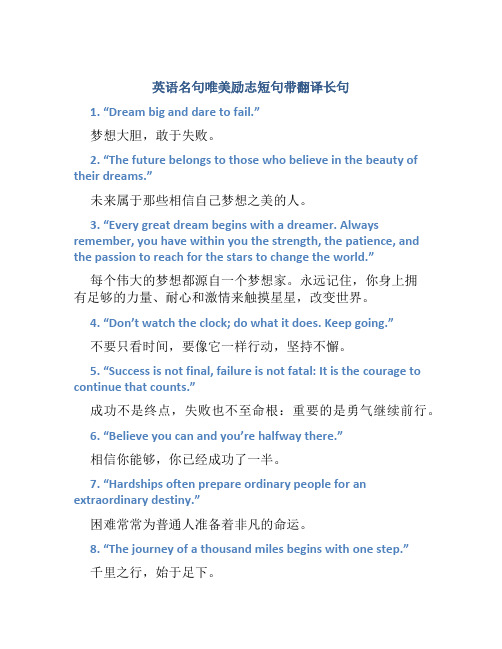
英语名句唯美励志短句带翻译长句1. “Dream big and dare to fail.”梦想大胆,敢于失败。
2. “The future belongs to those who believe in the beauty of their dreams.”未来属于那些相信自己梦想之美的人。
3. “Every great dream begins with a dreamer. Always remember, you have within you the strength, the patience, and the passion to reach for the stars to change the world.”每个伟大的梦想都源自一个梦想家。
永远记住,你身上拥有足够的力量、耐心和激情来触摸星星,改变世界。
4. “Don’t watch the clock; do what it does. Keep going.”不要只看时间,要像它一样行动,坚持不懈。
5. “Success is not final, failure is not fatal: It is the courage to continue that counts.”成功不是终点,失败也不至命根:重要的是勇气继续前行。
6. “Believe you can and you’re halfway there.”相信你能够,你已经成功了一半。
7. “Hardships often prepare ordinary people for an extraordinary destiny.”困难常常为普通人准备着非凡的命运。
8. “The journey of a thousand miles begins with one step.”千里之行,始于足下。
9. “It does not matter how slowly you go as long as you do not stop.”重要的不是走得多快,只要不停下脚步。
英语长句的翻译技巧
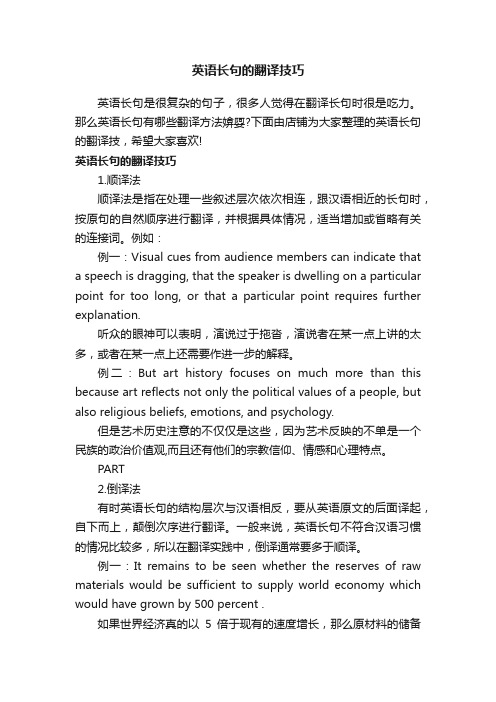
英语长句的翻译技巧英语长句是很复杂的句子,很多人觉得在翻译长句时很是吃力。
那么英语长句有哪些翻译方法媕娿?下面由店铺为大家整理的英语长句的翻译技,希望大家喜欢!英语长句的翻译技巧1.顺译法顺译法是指在处理一些叙述层次依次相连,跟汉语相近的长句时,按原句的自然顺序进行翻译,并根据具体情况,适当增加或省略有关的连接词。
例如:例一:Visual cues from audience members can indicate that a speech is dragging, that the speaker is dwelling on a particular point for too long, or that a particular point requires further explanation.听众的眼神可以表明,演说过于拖沓,演说者在某一点上讲的太多,或者在某一点上还需要作进一步的解释。
例二:But art history focuses on much more than this because art reflects not only the political values of a people, but also religious beliefs, emotions, and psychology.但是艺术历史注意的不仅仅是这些,因为艺术反映的不单是一个民族的政治价值观,而且还有他们的宗教信仰、情感和心理特点。
PART2.倒译法有时英语长句的结构层次与汉语相反,要从英语原文的后面译起,自下而上,颠倒次序进行翻译。
一般来说,英语长句不符合汉语习惯的情况比较多,所以在翻译实践中,倒译通常要多于顺译。
例一:It remains to be seen whether the reserves of raw materials would be sufficient to supply world economy which would have grown by 500 percent .如果世界经济真的以5倍于现有的速度增长,那么原材料的储备是否能充分满足其需求,尚不得而知。
英语长难句分析英语长句结构分析及翻译实例
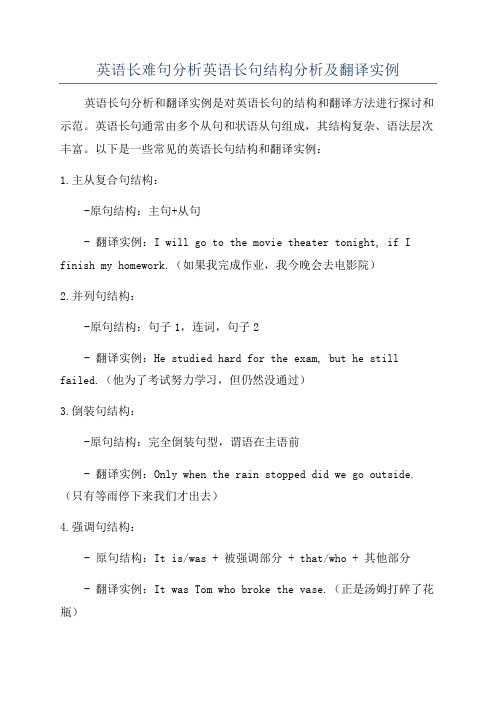
英语长难句分析英语长句结构分析及翻译实例英语长句分析和翻译实例是对英语长句的结构和翻译方法进行探讨和示范。
英语长句通常由多个从句和状语从句组成,其结构复杂、语法层次丰富。
以下是一些常见的英语长句结构和翻译实例:
1.主从复合句结构:
-原句结构:主句+从句
- 翻译实例:I will go to the movie theater tonight, if I finish my homework.(如果我完成作业,我今晚会去电影院)
2.并列句结构:
-原句结构:句子1,连词,句子2
- 翻译实例:He studied hard for the exam, but he still failed.(他为了考试努力学习,但仍然没通过)
3.倒装句结构:
-原句结构:完全倒装句型,谓语在主语前
- 翻译实例:Only when the rain stopped did we go outside.(只有等雨停下来我们才出去)
4.强调句结构:
- 原句结构:It is/was + 被强调部分 + that/who + 其他部分
- 翻译实例:It was Tom who broke the vase.(正是汤姆打碎了花瓶)
对于长句的翻译,可以采取以下方法:
-分割长句,将从句、状语从句分别翻译,再进行合并。
-对英语长句进行拆分,将其翻译为多个简洁且清晰的句子。
-确保翻译的流畅性和准确性,同时要注意语序的变化。
总之,对于英语长句的结构分析和翻译实例,重要的是理解其语法结构、使用正确的连词、灵活运用翻译策略,并保持翻译的准确和自然。
长句的翻译
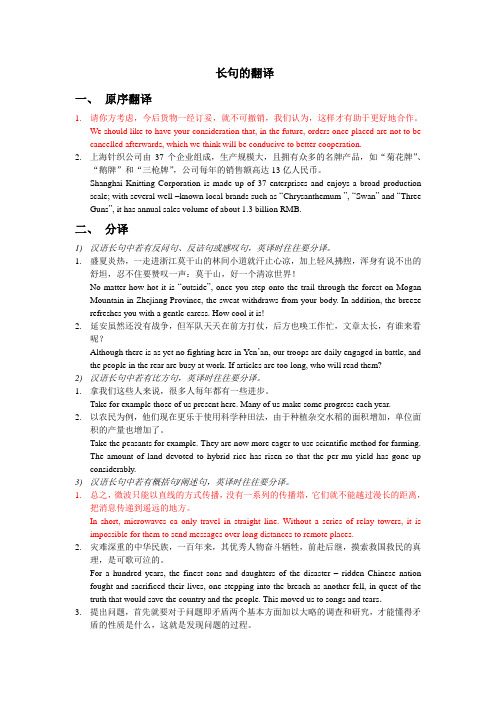
长句的翻译一、原序翻译1.请你方考虑,今后货物一经订妥,就不可撤销,我们认为,这样才有助于更好地合作。
We should like to have your consideration that, in the future, orders once placed are not to be cancelled afterwards, which we think will be conducive to better cooperation.2.上海针织公司由37个企业组成,生产规模大,且拥有众多的名牌产品,如“菊花牌”、“鹅牌”和“三枪牌”,公司每年的销售额高达13亿人民币。
Shanghai Knitting Corporation is made up of 37 enterprises and enjoys a broad production scale; with several well –known local brands such as “Chrysanthemum ”, “Swan” and “Three Guns”, it has annual sales volume of about 1.3 billion RMB.二、分译1)汉语长句中若有反问句、反诘句或感叹句,英译时往往要分译。
1.盛夏炎热,一走进浙江莫干山的林间小道就汗止心凉,加上轻风拂煦,浑身有说不出的舒坦,忍不住要赞叹一声:莫干山,好一个清凉世界!No matter how hot it is “outside”, once you step onto the trail through the forest on Mogan Mountain in Zhejiang Province, the sweat withdraws from your body. In addition, the breeze refreshes you with a gentle caress. How cool it is!2.延安虽然还没有战争,但军队天天在前方打仗,后方也唤工作忙,文章太长,有谁来看呢?Although there is as yet no fighting here in Yen’an, our troops are daily engaged in battle, and the people in the rear are busy at work. If articles are too long, who will read them?2)汉语长句中若有比方句,英译时往往要分译。
考研英语:如何翻译英语长难句

考研英语:如何翻译英语长难句什么是英语长句,特点和分析方法复合长句即包含各种语法关系和特殊句型的句子。
英语多长句,这是因为英语可以有后置定语。
扩展的后置定语可以是带从句或长修饰语的复杂句。
长句在科技性的文体中的出现频率很高,因此也就成为研究生英语考试的重点。
通过对近年来试题的分析,我们可以看出,所考的绝大多数都是长句。
这些句子结构复杂,逻辑性强,翻译起来困难相当大。
但是,无论多长的句子、多么复杂的结构,它们都是由一些基本的成分组成的。
只要弄清英语原文的句法结构,找出整个句子的中心内容及其各层意思,然后分析各层意思之间的逻辑关系,再按汉语的特点和表达方式就可以译出原文了。
在长句的英译汉实践中,我们始终应记住英汉在句法结构上的差异,不必拘泥于形式。
61.什么是英语长句?英语长句一般指的是各种复杂句,复杂句里可能有多个从句,从句与从句之间的关系可能包孕、嵌套,也可能并列,平行。
所以翻译长句,实际上我们的重点主要放在对各种从句的翻译上。
从功能来说,英语有三大复合句,即:①名词性从句,包括主语从句、宾语从句、表语从句和同位语从句;②形容词性从句,即我们平常所说的定语从句;③状语从句。
62.英语长句的特点是什么?一般说来,英语长句有如下几个特点:1)结构复杂,逻辑层次多;2)常须根据上下文作词义的引申;3)常须根据上下文对指代词的指代关系做出判断;4)并列成分多;5)修饰语多,特别是后置定语很长;6)习惯搭配和成语经常出现。
63.英语长句的分析方法是什么?1)找出全句的主语、谓语和宾语,即句子的主干结构;2)找出句中所有的谓语结构、非谓语结构、介词短语和从句的引导词;3)分析从句和短语的功能,例如,是否为主语从句、宾语从句、表语从句或状语从句等;以及词,短语和从句之间的关系;4)分析句子中是否有固定词组或固定搭配、插入语等其他成分。
长句翻译的步骤举例:经典例题470 In Africa I met a boy,who was crying as if his heart would break and said,when I spoke to him,that he was hungry because he had had no food for two days. 分析:第一,拆分句子:这个长句可以拆分为四段:In Africa I met a boy/who was crying as if his heart would break/when I spoke to him,that he was hungry because/he had had no food for two days. 第二,句子的结构分析:(1)主干结构是主语+过去式+宾语:I met a boy…。
[全]复杂的英语长句翻译详解
![[全]复杂的英语长句翻译详解](https://img.taocdn.com/s3/m/7279dba0a417866fb94a8e2f.png)
复杂的英语长句翻译详解首先,熟悉一下陌生的单词:Interpol:国际刑警组织,全称是International Criminal Police Organization red notice:也就是我们经常听到的“红通”,和“issue”搭配。
issue做“发出”、“签发”解释时,后接宾语通常是比较正式的“通知”。
fugitive:逃亡的heir:继承人hit-and-run:肇事逃逸接下来看到原文。
可以看到原文的主语是interpol,但我在处理的时候换掉了主语,并变成了一个被动句。
这样做的目的在于方便组织,另外还因为这个句子的所有信息基本都指向了arrest后面的宾语heir。
所以干脆以他为主,再将主动语态变成被动语态。
“for his role in"被我直接省略为一个“因”字,因为后面的”fatal hit-and-run“就是前面arrest的宾语heir造成的(查看相关报道或后文可以得知,所以翻译还要会查证),所以这几个词在这里原文用于起到连接前后信息作用的结构,表示前后为因果关系而已。
再来看“fatal hit-and-run”,如果直接按照原文的顺序译,那就是“致命的肇事逃逸案件”。
但如果我们拆开来看,可以清楚地得出“fatal”是此次“hit-and-run”的后果。
所谓“致命”,放在这样的语境,用“致人死亡”更适合。
所以把“fatal hit-and-run”译成“肇事逃逸致人死亡”。
“fugitive”被翻译成“(目前在逃)”,用括号把它处理了。
这是因为后面的“to the Red Bull billions"实质上也是一个限定性的片段,为了避免宾语heir在翻译时前面的限定性词语太多而造成句子不顺畅,所以把其中挪到后面用括号处理掉。
第一句最后一个要注意的点是“Thai heir to the Red Bull billions"。
从译文可以看出,我把”Thai"和“Red Bull”合在了一起,因为从文中的人名、标题和文中的前后文,都可以知道,这里指的是“泰国红牛”。
长句的翻译

译文: 由于人民生活水平的不断提高以及计划生育, 中国的家庭结构发生着缓慢却又具有实质性的变化, 必须根据这一历史背景考虑人到老年的问题。
分析:这是一个因果句,against 引导一个原因状语从 句。按照汉语先说原因后说结果,先叙述事实后表明 见解的习惯,翻译时需倒译。
【4】Such is human nature in the West that a great many people are often wiling to sacrifice higher pay for the privilege of becoming white collar workers.
down and sending out wireless messages, the lieutenant(中尉) confusedly studying the map to
make out what the messages meant and appealing for aid now and then to the sergeant(中士) .
译文: 这个年轻人走了很远的路之后碰上了一个愚蠢的人,这个 人把一条裤子系在两棵树之间,正在尽全身力气向上跳,想在落 下来时两条腿正好套进两只裤脚里去。
二、逆译法
如果语序跟汉语习惯不同,甚至完全相反时。
2.1 改变定语顺序 (前置到先行词前)
【2】 The battle-scarred old communists who once made stormy revolution unfurled a passionate blueprint today for a modern, peaceful and prosperous China .
汉译英翻译技巧-长句的翻译_大学英语
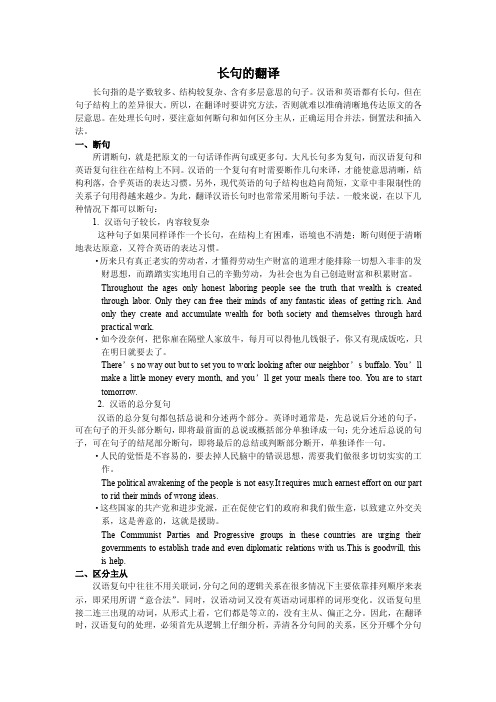
长句的翻译长句指的是字数较多、结构较复杂、含有多层意思的句子。
汉语和英语都有长句,但在句子结构上的差异很大。
所以,在翻译时要讲究方法,否则就难以准确清晰地传达原文的各层意思。
在处理长句时,要注意如何断句和如何区分主从,正确运用合并法,倒置法和插入法。
一、断句所谓断句,就是把原文的一句话译作两句或更多句。
大凡长句多为复句,而汉语复句和英语复句往往在结构上不同。
汉语的一个复句有时需要断作几句来译,才能使意思清晰,结构利落,合乎英语的表达习惯。
另外,现代英语的句子结构也趋向简短,文章中非限制性的关系子句用得越来越少。
为此,翻译汉语长句时也常常采用断句手法。
一般来说,在以下几种情况下都可以断句:1. 汉语句子较长,内容较复杂这种句子如果同样译作一个长句,在结构上有困难,语境也不清楚;断句则便于清晰地表达原意,又符合英语的表达习惯。
·历来只有真正老实的劳动者,才懂得劳动生产财富的道理才能排除一切想入非非的发财思想,而踏踏实实地用自己的辛勤劳动,为社会也为自己创造财富和积累财富。
Throughout the ages only honest laboring people see the truth that wealth is created through labor. Only they can free their minds of any fantastic ideas of getting rich. And only they create and accumulate wealth for both society and themselves through hard practical work.·如今没奈何,把你雇在隔壁人家放牛,每月可以得他几钱银子,你又有现成饭吃,只在明日就要去了。
There’s no way out but to set you to work looking after our neighbor’s buffalo. Y ou’ll make a little money every month, and you’ll get your meals there too. Y ou are to start tomorrow.2. 汉语的总分复句汉语的总分复句都包括总说和分述两个部分。
汉英翻译-长句的翻译课件

方式,人物的形象也跃然纸上。可以说,
两种译文各有千秋,但这种情况下,还是 译文2胜出,因为其较好的包流量人物的形 象。
• 三、宾语
农学家深知繁育我们今天所能得到的各种玉米花费了(农 民们)好几百年的时光。 【译文】farm experts know that it has taken hundreds of
• 2、矿物燃料每年释放52亿公吨二氧 化碳进入大气,同时热带森林的燃烧 大约释放出18亿公吨二氧化碳——这 两方面都对二氧化碳的集结产生作用, 因而会引发温室效应。
• 【译文】Fossil fuels set off 5.2
billion metric tons of CO₂ into the
aical forests emits roughly 1.8
• 【译文2】“you’re a nice one!” she said. “you made me mix all this ink for you this morning, sat down in a state of great enthusiasm, wrote just three characters, threw down the brush again, rushed out, and left me waiting here all day for you to come back and finish. Now you just sit down here and use this ink up, and perhaps I’ll let the matter pass!”(霍 克斯 译)
• 【点评】原句虽然较长,但分析后不难得出句意 间的因果关系。先是总述其结果,其后是句子的 原因状语“因为经济上不去”,最后又做了详细 的分述。句子中这种先果后因的顺序正好与英语 思维一致,因此我们可以采用顺译法来处理此句 中的状语成分。
长句翻译技巧
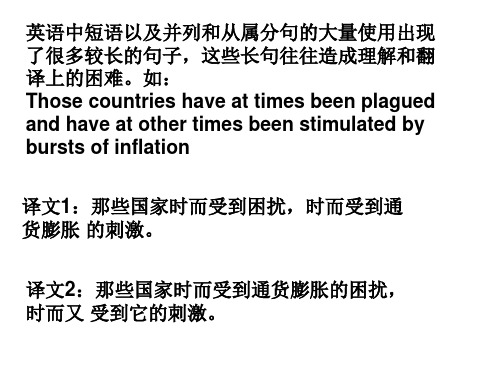
1. It was the school's responsibility to make good citizens out of the students, and the parents' responsibility to teach the children to read and write.
3 拆句译法 有的时候, 有的时候,简单地把句子各成分的位置进行挪动调换 还是不够的。由于英语句子中修饰成分的大量运用, 还是不够的。由于英语句子中修饰成分的大量运用,使得 一个句子所包含的信息大大超过汉语单句的承受力, 一个句子所包含的信息大大超过汉语单句的承受力,所以 汉语句子往往要把它进行化解,各个击破, 汉语句子往往要把它进行化解,各个击破,这就是所谓的 拆句译法。例如: 拆句译法。例如: Three rains had passed, and it was that lean season when the village's store of grain and other dried foods from the last harvest was almost gone. 这个句子由两个并列分句组成,包含三层相对独立的意思: 这个句子由两个并列分句组成,包含三层相对独立的意思: 1)雨季过去了;2)到了青黄不接的季节;3)上季贮藏的 )雨季过去了; )到了青黄不接的季节; ) 食物已吃光。因此在译文中可拆开分别叙述: 食物已吃光。因此在译文中可拆开分别叙述:
7. If you reach Chicago by train and spend only an hour or two there you will fives it the name "Windy City." .
【口译考试】:CATTI《口译综合能力》题型分析
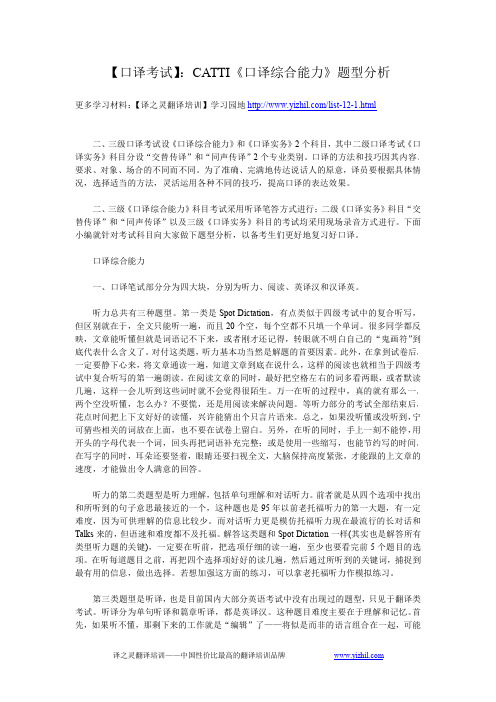
【口译考试】:CATTI《口译综合能力》题型分析更多学习材料:【译之灵翻译培训】学习园地/list-12-1.html二、三级口译考试设《口译综合能力》和《口译实务》2个科目,其中二级口译考试《口译实务》科目分设“交替传译”和“同声传译”2个专业类别。
口译的方法和技巧因其内容、要求、对象、场合的不同而不同。
为了准确、完满地传达说话人的原意,译员要根据具体情况,选择适当的方法,灵活运用各种不同的技巧,提高口译的表达效果。
二、三级《口译综合能力》科目考试采用听译笔答方式进行;二级《口译实务》科目“交替传译”和“同声传译”以及三级《口译实务》科目的考试均采用现场录音方式进行。
下面小编就针对考试科目向大家做下题型分析,以备考生们更好地复习好口译。
口译综合能力一、口译笔试部分分为四大块,分别为听力、阅读、英译汉和汉译英。
听力总共有三种题型。
第一类是Spot Dictation,有点类似于四级考试中的复合听写,但区别就在于,全文只能听一遍,而且20个空,每个空都不只填一个单词。
很多同学都反映,文章能听懂但就是词语记不下来,或者刚才还记得,转眼就不明白自己的“鬼画符”到底代表什么含义了。
对付这类题,听力基本功当然是解题的首要因素。
此外,在拿到试卷后,一定要静下心来,将文章通读一遍,知道文章到底在说什么,这样的阅读也就相当于四级考试中复合听写的第一遍朗读。
在阅读文章的同时,最好把空格左右的词多看两眼,或者默读几遍,这样一会儿听到这些词时就不会觉得很陌生。
万一在听的过程中,真的就有那么一、两个空没听懂,怎么办?不要慌,还是用阅读来解决问题。
等听力部分的考试全部结束后,花点时间把上下文好好的读懂,兴许能猜出个只言片语来。
总之,如果没听懂或没听到,宁可猜些相关的词放在上面,也不要在试卷上留白。
另外,在听的同时,手上一刻不能停,用开头的字母代表一个词,回头再把词语补充完整;或是使用一些缩写,也能节约写的时间。
在写字的同时,耳朵还要竖着,眼睛还要扫视全文,大脑保持高度紧张,才能跟的上文章的速度,才能做出令人满意的回答。
英语长句的翻译

• We hear what they said and view what they did; we see them as if they were really alive; we sympathize with them, enjoy with them, grieve with them; their experience becomes ours, and we feel as if we were in a measure actors with them in the scenes which they describe. • 我们如闻其声,如观其行,如见其人; 我们同情 他们,和他们悲喜与共;他们的感受成为我们 自己的感受,我们觉得仿佛自己是在他们所 描绘的场景中与他们同台扮演着角色.
• It is popular for the fine views from the summit of the mountain. • 从山顶远眺,湖光山色,尽收眼底;这儿风景绝佳,遐迩闻 名. • 译者从最后一个介词短语译起,倒着译到第二个介词短 语,最后才译原句主谓结构. • One could account for what was observed equally well on the theory that the universe had existed forever or on the theory that it was set in motion at some finite time in such a manner as to look as though it had existed forever. • 当时有两种理论摆在大家面前:一种理论认为,宇宙是 一直存在的;另一种理论认为,宇宙是在某个有限的时 刻启动的,但给人的印象却似乎是一直存在的.但是,不 管按照哪种理论,我们都可以很好地解释所观察到的事 实.
长句翻译汉译英
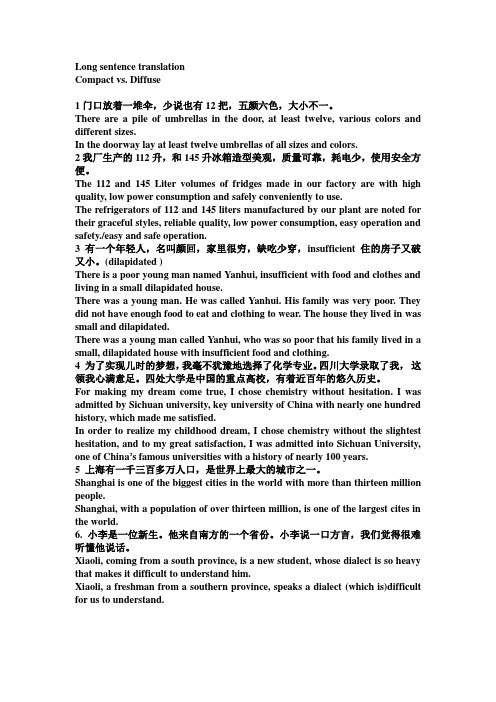
Long sentence translationCompact vs. Diffuse1门口放着一堆伞,少说也有12把,五颜六色,大小不一。
There are a pile of umbrellas in the door, at least twelve, various colors and different sizes.In the doorway lay at least twelve umbrellas of all sizes and colors.2我厂生产的112升,和145升冰箱造型美观,质量可靠,耗电少,使用安全方便。
The 112 and 145 Liter volumes of fridges made in our factory are with high quality, low power consumption and safely conveniently to use.The refrigerators of 112 and 145 liters manufactured by our plant are noted for their graceful styles, reliable quality, low power consumption, easy operation and safety./easy and safe operation.3 有一个年轻人,名叫颜回,家里很穷,缺吃少穿,insufficient 住的房子又破又小。
(dilapidated )There is a poor young man named Yanhui, insufficient with food and clothes and living in a small dilapidated house.There was a young man. He was called Yanhui. His family was very poor. They did not have enough food to eat and clothing to wear. The house they lived in was small and dilapidated.There was a young man called Yanhui, who was so poor that his family lived in a small, dilapidated house with insufficient food and clothing.4 为了实现儿时的梦想,我毫不犹豫地选择了化学专业。
英语翻译长句翻译的译文
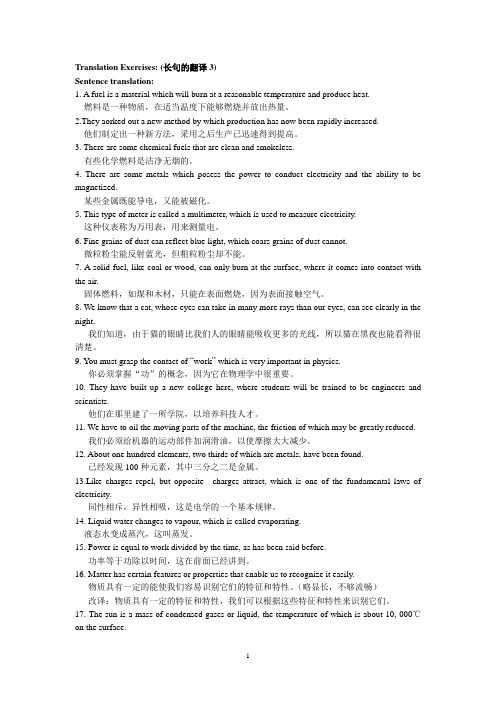
Translation Exercises: (长句的翻译3)Sentence translation:1. A fuel is a material which will burn at a reasonable temperature and produce heat.燃料是一种物质,在适当温度下能够燃烧并放出热量。
2.They aorked out a new method by which production has now been rapidly increased.他们制定出一种新方法,采用之后生产已迅速得到提高。
3. There are some chemical fuels that are clean and smokeless.有些化学燃料是洁净无烟的。
4. There are some metals which posess the power to conduct electricity and the ability to be magnetized.某些金属既能导电,又能被磁化。
5. This type of meter is called a multimeter, which is used to measure electricity.这种仪表称为万用表,用来测量电。
6. Fine grains of dust can reflect blue light, which coars grains of dust cannot.微粒粉尘能反射蓝光,但粗粒粉尘却不能。
7. A solid fuel, like coal or wood, can only burn at the surface, where it comes into contact with the air.固体燃料,如煤和木材,只能在表面燃烧,因为表面接触空气。
8. We know that a cat, whose eyes can take in many more rays than our eyes, can see clearly in the night.我们知道,由于猫的眼睛比我们人的眼睛能吸收更多的光线,所以猫在黑夜也能看得很清楚。
2020考研英语高分长句翻译
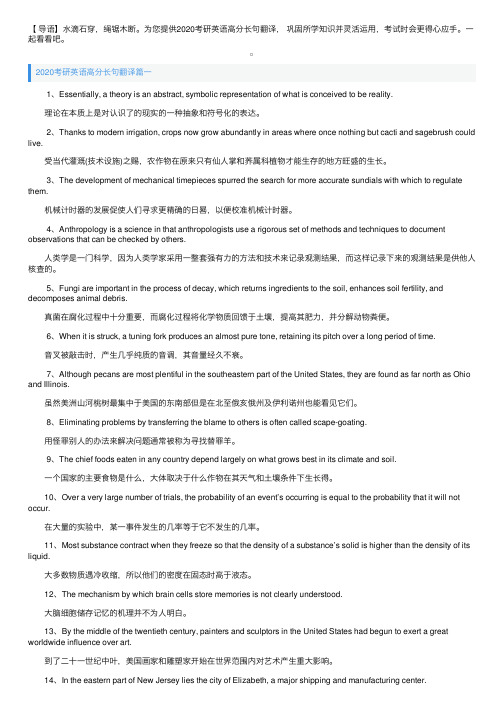
【导语】⽔滴⽯穿,绳锯⽊断。
为您提供2020考研英语⾼分长句翻译,巩固所学知识并灵活运⽤,考试时会更得⼼应⼿。
⼀起看看吧。
2020考研英语⾼分长句翻译篇⼀ 1、Essentially, a theory is an abstract, symbolic representation of what is conceived to be reality. 理论在本质上是对认识了的现实的⼀种抽象和符号化的表达。
2、Thanks to modern irrigation, crops now grow abundantly in areas where once nothing but cacti and sagebrush could live. 受当代灌溉(技术设施)之赐,农作物在原来只有仙⼈掌和荞属科植物才能⽣存的地⽅旺盛的⽣长。
3、The development of mechanical timepieces spurred the search for more accurate sundials with which to regulate them. 机械计时器的发展促使⼈们寻求更精确的⽇晷,以便校准机械计时器。
4、Anthropology is a science in that anthropologists use a rigorous set of methods and techniques to document observations that can be checked by others. ⼈类学是⼀门科学,因为⼈类学家采⽤⼀整套强有⼒的⽅法和技术来记录观测结果,⽽这样记录下来的观测结果是供他⼈核查的。
5、Fungi are important in the process of decay, which returns ingredients to the soil, enhances soil fertility, and decomposes animal debris. 真菌在腐化过程中⼗分重要,⽽腐化过程将化学物质回馈于⼟壤,提⾼其肥⼒,并分解动物粪便。
高考英语长难句语法解析与翻译
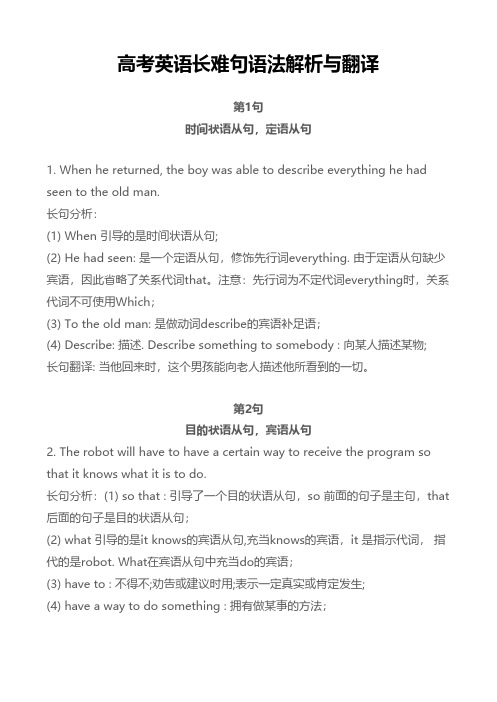
高考英语长难句语法解析与翻译第1句时间状语从句,定语从句1. When he returned, the boy was able to describe everything he had seen to the old man.长句分析:(1) When 引导的是时间状语从句;(2) He had seen: 是一个定语从句,修饰先行词everything. 由于定语从句缺少宾语,因此省略了关系代词that。
注意:先行词为不定代词everything时,关系代词不可使用Which;(3) To the old man: 是做动词describe的宾语补足语;(4) Describe: 描述. Describe something to somebody : 向某人描述某物;长句翻译: 当他回来时,这个男孩能向老人描述他所看到的一切。
第2句目的状语从句,宾语从句2. The robot will have to have a certain way to receive the program so that it knows what it is to do.长句分析:(1) so that : 引导了一个目的状语从句,so 前面的句子是主句,that 后面的句子是目的状语从句;(2) what 引导的是it knows的宾语从句,充当knows的宾语,it 是指示代词, 指代的是robot. What在宾语从句中充当do的宾语;(3) have to : 不得不;劝告或建议时用;表示一定真实或肯定发生;(4) have a way to do something : 拥有做某事的方法;长句翻译:机器人必须有一个特定的方式来接收程序,这样它才能知道它要做什么。
第3句定语从句3. The company Jackie chose planned to employ only one person, but more than twenty people applied for the job.长句分析:(1) 并列连词but 链接了两并列句,前面一个句子为复合句;(2) Jackie chose: 是一个定语从句,用来修饰先行词company的,由于定语从句中缺少宾语,所以该定语从句省略了关系代词that/which;(3) Choose: 选择;选取;挑选;决定;过去式:chose, 过去分词:chosen;(4) Plan to do something: 计划做某事;(5) More than + 数量词: 超过,多余,相当于over;(6) Apply for : 提出申请;申请…职位;请求;长句翻译: 杰基选择的那家公司只打算雇用一个人,但有二十多个人申请了这份工作。
英语难句和长句的翻译

英语难句和长句的翻译在本文中作者从多年来的教学实践和经验出发,结合学生在英语四、六级考试中把英语翻译为汉语经常出的问题,探讨了把英语中的难句和长句翻译为既通顺又忠实于原文意义的汉语的基本技巧和方法。
标签:英语难句;翻译;技巧我们在英语学习过程中,往往碰到一些英语句子,这些句子本身很长,结构又复杂,翻译成汉语时有很大难度,在英语四、六级考试题中,把英语翻译成汉语的句子大多如此,许多大学生在翻译时都感到很棘手。
那么,如何才能把这些结构复杂、本身又很长的英语句子翻译为既通顺又忠实于原文意义的汉语呢?下面简单介绍一些翻译这些英语难句和长句的基本方法和技巧。
一、顺序法有些句子结构复杂的英语长句所叙述的一连串动作基本上是按动作发生的先后顺序安排,有些英语长句的内容是按其逻辑关系安排,这些与汉语的表达方式和习惯比较接近,翻译时一般可以按照原文的顺序译出。
例如:⑴If she had long lost the blue-eyed, flower-like charm, the cool slim purity of face and form, the apple-blossom coloring ⑵which had so swiftly and oddly affected Ashurst twenty-six years ago, ⑶she was still at forty-three a comely and faithful companion, ⑷whose cheeks were faintly mottled, ⑸and whose gray-blue eyes had acquired a certain fullness.分析:这个句子是由一个主句、一个状语从句和三个定语从句组成的。
“她依旧是个好看而忠实的伴侣”是主句,也是全句的中心内容。
主句前是一个假设状语从句,其中又包含一个定语从句,这个定语从句又很长。
长难句翻译的五大方法

考研英语中,阅读理解衍生出来的一个题型就是翻译。
翻译其实是最好拿分的一个题型。
为什么这样说呢?翻译题型的词汇一般是认识的,最主要的一点就是碰到最难翻译的长句该怎么办?而英语习惯于用长的句子表达比较复杂的概念,汉语则不同,常常使用若干短句作层次分明的叙述。
因此,在进行英译汉时,万学海文提醒大家要特别注意英语和汉语之间的差异,将英语的长句分解翻译成汉语的短句,这样翻译做起来就容易得分多了。
在英语长句的翻译过程中,我们一般采取下列的方法:(1) 顺序法当英语长句的内容叙述层次与汉语基本一致时,可以按照英语原文表达的层次顺序翻译成汉语,从而使译文与英语原文的顺序基本一致。
例如:But now it is realized that supplies of some of them are limited, and it is even possible to give a reasonable estimate of their “expectation of life”, the time it will take to exhaust all known sources and reserve s of these materials.(84年考题)分析:该句的骨干结构为“It is realized that …”,it为形式主语,that 引导主语从句以及并列的it is even possible to …结构,其中,不定式作主语,the time …是“expectation of life”的同位语,进一步解释其含义,而time后面的句子是它的定语从句。
五个谓语结构表达了四个层次的意义:A. 可是现在人们意识到;B. 其中有些矿物质的蕴藏量是有限的;C. 人们甚至还可以比较合理地估计出这些矿物质“可望存在多少年”;D. 将这些已知矿源和储量将消耗殆尽的时间。
根据同位语从句的翻译方法,把第四层意义的表达作适当的调整, 整个句子就翻译为:可是现在人们意识到,其中有些矿物质的蕴藏量是有限的,人们甚至还可以比较合理的估计出这些矿物质“可望存在多少年”,也就是说,经过若干年后,这些矿物的全部已知矿源和储量将消耗殆尽。
英语长难句翻译技巧及方法

英语长难句翻译技巧及方法英汉两种语言句子的不同特点是:英语书面语长句较多;汉语一般短句较多。
英语句子结构较紧,多用主人结构,英语可有各种后置修饰语(介词短语、不定式短语、动名词短语、分词短语以及从句),这些成分都是造成英语长句的原因;汉语句子结构较松,多用并列结构。
有翻译经验的人们对这些特点作过形象的比喻,把英语句子结构比作“葡萄”,把汉语句子结构比作“竹节”。
翻译长句时,可将英语的葡萄结构拆成汉语的竹节结构,即把成串的拆成成条的。
英汉两种语言的语序差异是:英语时间顺序灵活(表示时间的从句可以在主句之前或之后);汉语一般是从先到后。
英语逻辑顺序也比较灵活(表示原因、条件的从句可以在主句之前或之后);汉语一般是前因后果,先进条年,后谈结果。
英语中的句词性从句(主语从句、表语从句、宾语从句、同位语从句)与汉语句子主谓宾的语序基本一致,因此,一般都可按汉语的表达方式处理。
顺序法如果英语长句的时间顺序、逻辑顺序以及名词性从句与汉语句子的语序基本相似,一般可按原文顺序译:如:本句时间状语从句在前,用顺序法译。
(1)As it was a fine day and I was in no hurry, I was taking my time, looking in shop windows, strolling in the park, and sometimes just stopping and looking around me. 由于天气晴朗,当时又无急事,我便慢悠悠看看橱窗,逛逛公园。
有时干脆停下脚步,四处张望。
逆序法如果英语长句的时间顺序、逻辑顺序与汉语句子的语序相反,一般可逆原文顺序译。
如:(2)“Neither believe nor reject anything,” he wrote to his nephew, “because any other person has rejected or believed it ……”他在给侄子的信中写道:“不要因为别的人相信或拒绝了什么东西,你也就去相信它或拒绝它。
- 1、下载文档前请自行甄别文档内容的完整性,平台不提供额外的编辑、内容补充、找答案等附加服务。
- 2、"仅部分预览"的文档,不可在线预览部分如存在完整性等问题,可反馈申请退款(可完整预览的文档不适用该条件!)。
- 3、如文档侵犯您的权益,请联系客服反馈,我们会尽快为您处理(人工客服工作时间:9:00-18:30)。
长句的翻译-复杂的长句
泛瑞翻译
在法律翻译中,最难处理的莫过于“长句”。
“长句”具有两个典型特点:句子字数多,起码要超过50个单词;句子结构复杂,从句和各种修饰性成分较多。
在法律英语中,“长句”出现的频率远远多于等其他英语作品。
可以说,正确地理解和翻译长句,是法律翻译成败的关键。
对于法律英语中的“长句”,可以通过“拆分一组合”翻译法加以翻译。
具体而言,就是要首先按照从宏观到微观的原则,将“长句”拆分成“短句”,进而分析出句子的主体结构;然后再把“短句”翻译出来;最后再把译文组合成通顺的汉语。
其中的关键是“拆分”长句和“组合”译文。
在“拆分”长句的过程中,有一些拆分的“标志”:第一,句子中有标点符号的,可以从标点符号的位置,将句子分割开。
第二,句子中有“连接词”的,可以将句子从“连接词”处进一步分割;所谓的“连接词”包括表示逻辑关系的词,比如and, or, but, however等;引导从句的词,如that, which, when, where,while等。
第三,句子中有介词短语的,比如at, for, in 等介词所引导的介词成分,可以对介词成分进行进一步的分割。
在“组合”译文的过程中,要注意其中的逻辑关系,在英一汉法律翻译处理上,最终的译文要符合汉语的表达习惯,达到准确、通顺、易懂的标准。
在法律英语中长句的形成主要体现为以下三种方式:第一,复杂的从句;第二,多个并列结构;第三,多个分句。
本课将通过例句具体分析上述三种类型“长句”的翻译及技巧。
一、复杂的从句
通过多个从句来使句子结构复杂化,是增加句子长度的重要方式,例如:
例1:When the goods have arrived at their destination,the consignee that demands de-livery of the goods under the contract of carriage shall accept delivery of the goods at the time or within the
time period and at the location agreed in the contract of carriage or,failing such agreement,at the time and location at which,having regard to the terms of the contract,the customs,usages or practices of the trade and the circumstances of the carriage, delivery could reasonably be expected.
这一句共有83个单词,具体翻译步骤如下:
步骤1:“拆分”句子,找出句子的主体结构。
在这一句中,有多个从句:when引导的状语从句,that和which引导的定语从句。
此外,该句中还有or和and引导的多个并列结构,以及at引导的介词成分。
经过分析,本句的主体结构是:the consignee shall accept delivery of the goods。
需要注意的是,在which引导的定语从句中,有一个插入语:having regard to
步骤2:分别翻译分割后的短句。
When the goods have arrived at their destination:当货物到达目的地时。
the consignee that demands delivery of the goods under the contract of carriage:要求交付货物的收货人。
having regard to the terms of the contract, the customs,usages or practices of the trade and the circumstances of the carriage:应当在考虑到合同条款和行业习惯、惯例或者习惯做法以及运输情形。
at the time and location at which delivery could reasonably be expected:能够合理预期的交货时间和地点。
步骤3:“组合”汉语译文:当货物到达目的地时,按照运输合同要求交付货物的收货人应在运输合同约定的时间或者期限内,在运输合同约定的地点接受交货;无约定的,应考虑到合同条款和行业习惯、行业惯例或行业做法以及运输情形,在能够合理预期的交货时间和地点接受交货。
类似的例子还有:
例2 :Where the seller sells goods in the course of a business and the buyer,expressly or by implication,makes known to the seller any particular purpose for which the goods are being
bought,there is an implied condition that the goods supplied under the contract are reasonably fit for that purpose,whether or not that is a purpose for which such goods are commonly supplied,except where the circumstances show that the buyer does not rely t or that it is unreasonable for him to rely, on the seller’s skill or judgment.
这一句共有91个单词,具体翻译步骤如下:
步骤1:“拆分”句子,找出句子的主体结构。
这句话中有where引导的两个条件状语从句,which引导的两个定语从句,that引导的一个同位语从句(there is an implied condition that…),that引导的两个宾语从句,以及whether or not引导的一个状语从句。
这句话的主体结构是:there is an implied condition。
步骤2:分别翻译分割后的短句。
Where the seller sells goods in the course of a business and the buyer,expressly or by implication,makes known to the seller any particular purpose for which the goods are being bought:如果卖方在商业经营过程中出售货物,并且买方明示或默示地将购买货物所用于的特定目的告知卖方。
.
there is an implied condition:存在下述默示条件。
the goods supplied under the contract are reasonably fit for that purpose,whether or not that is a purpose for which such goods are commonly supplied:根据合同提供的货物将合理地适用于该目的,不论其是否为通常提供的货物所适用之目的。
except where the circumstances show that the buyer does not rely,or that it is unreasonable for him to rely,on the seller’s skill or judgment:除非情况表明买方不依赖卖方的技能或判断,或者买方对卖方的技能或判断产生依赖是不合理的。
步骤3:“组合”汉语译文:凡卖方在商业经营过程中出售货物且买方以明示或默示方式将其购买货物的特定目的告知卖方的,存在下述默示条件卖方按照合同提供的货物符合买方的购买目的,不论该目的是否为货物供应通常之目的,除非有情况表明买方不依赖卖方的技能或判断,或者买方对卖方的技能或判断产生依赖不合理。
